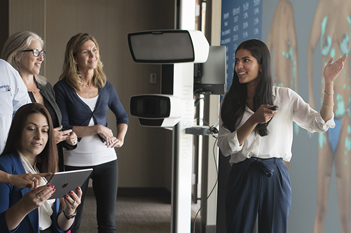"Investigation of the Precision of the VISIA® Complexion Analysis Camera System in the Assessment of Skin Surface Features" Featured in GMS Interdisciplinary Plastic and Reconstructive Surgery DGPW
Background:
The aim of this study was to independently investigate the precision of the high resolution Visia® camera, from Canfield Scientific, to capture several skin surface features.
Method:
Facial images of eight volunteers were taken with closed eyes and a relaxed face. The capture was conducted in a resting position within a positioning rig. Frontal view images were taken. In the first capture session, the images were captured three times in a row with the head steadily resting in the capture rig. Each volunteer then left the capture rig and returned to it one week later repositioning the face, and the capture was repeated three times. On the basis of this study, it was additionally investigated which number of study participants would be required in order to make a claim as to the reproducibility of the captures. As a possible approach to making this determination, a power analysis was considered. In order to conduct this analysis, it was necessary to determine which differences between individual image captures would be clinically acceptable. To answer this question, a subjective assessment of the repeated image captures for all study participants and for all skin surface features was conducted in order to identify any differences that were visible with the human eye.
Results:
Differences in skin criteria of the eight volunteers in terms of means and standard deviations were collected for weeks one and two. For the criteria skin texture, UV spots, brown spots and porphyrins, these differences were less than 2% and for pores and red areas they were between 2% and 4%. The results for spots and wrinkles were around 6%. Looking at the differences between the data from week one and two as well as the standard deviations, these differences turned out to be relatively small. This finding also pointed to a quite good precision of the measurement technique. The subjective assessment of the images of the eight participants on each of the eight skin criteria revealed that no differences were detectable in the recaptured versions of the images of the participants’ faces in their native digital forms solely with the human eye. There was an exception for only one participant, in whom a distinction between two image captures appeared to be subjectively visible with the human eye, but only for the criterion of red areas. As the subjective assessment revealed that no clinically relevant differences could be identified, a power analysis involving a test for significant differences between the recaptured images was discarded. As a consequence, the number of participants recruited for the study on the reproducibility of the system presented herein was deemed to be sufficient.
Conclusion:
The precision of the Visia® camera system was found to be satisfactory in this study. The Visia® camera helped to visualise skin features beyond what is visible to the human eye. Thus, the Visia® camera system provides new objective information on skin surface characteristics beyond what can be acquired through purely subjective assessments.
Most Recent News
- Prof. Rod Sinclair, MD Offers Free Skin Screenings with Canfield’s VECTRA® WB360
- Canfield’s VECTRA® WB360 is on Wheels! Australian Skin Cancer Foundation Launches New 3D Skin Check Mobile Clinic
- VISIA® Wins Best Imaging Device in MedEsthetics’ Readers’ Choice Awards!
- Canfield Scientific Concludes Successful Innovations in Imaging: A Canfield Symposium in Berlin
